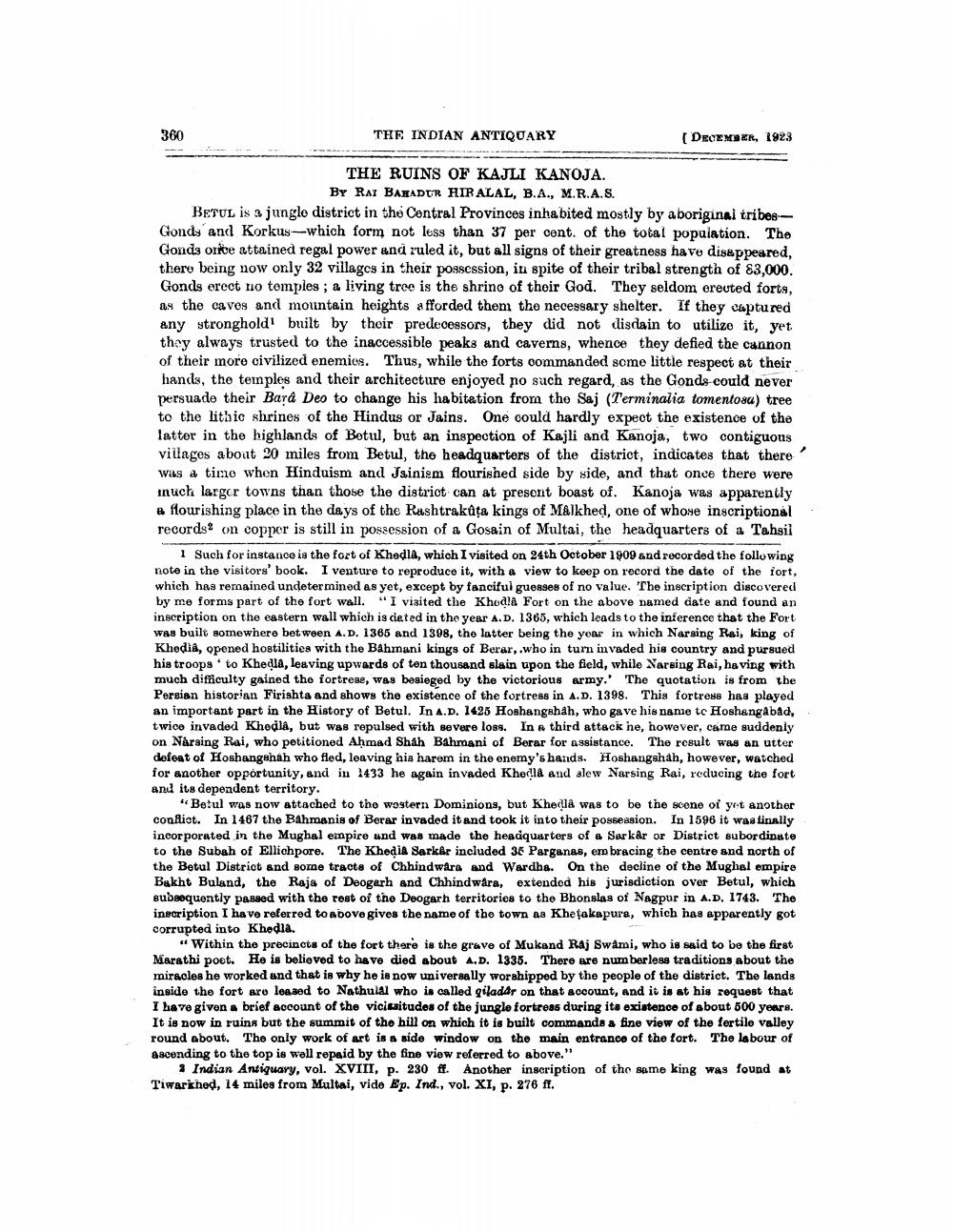________________
360
THE INDIAN ANTIQUARY
[ DECEMBER, 1923
THE RUINS OF KAJLI KANOJA.
BY RAI BAHADUR HIR ALAL, B.A., M.R.A.S. BETUL is a jungle district in the Contral Provinces inhabited mostly by aboriginal tribes-- Gonds and Korkus--which form not less than 37 per cent. of the total population. The Gonds ortbe attained regal power and ruled it, but all signs of their greatness have disappeared, there being now only 32 villages in their possession, in spite of their tribal strength of 83,000. Gonds erect no temples; a living tree is the shrino of their God. They seldom creuted forts, as the caves and mountain heights afforded them the necessary shelter. If they captured any stronghold built by their predecessors, they did not disdain to utilize it, yet they always trusted to the inaccessible peaks and caverns, whence they defied the cannon of their more civilized enemies. Thus, while the forts oommanded some little respect at their hands, the teinples and their architecture enjoyed no such regard, as the Gonds could never persuade their Bara Deo to change his habitation from the Saj (Terminalia tomentosu) tree to the lithic shrines of the Hindus or Jains. One could hardly expect the existence of the latter in the highlands of Betul, but an inspection of Kajli and Kanoja, two contiguous villages about 20 miles from Betul, the headquarters of the district, indicates that there was a time when Hinduism and Jainism flourished side by side, and that once there were inuch larger towns than those the district can at present boast of. Kanoja was apparently a flourishing place in the days of the Rashtrakůța kings of Malkhed, one of whose inscriptional records on copper is still in possession of a Gosain of Multai, the headquarters of a Tahsil
1 Such for instance is the fort of Khedia, which I visited on 24th October 1909 and recorded the following note in the visitors' book. I venture to reproduce it, with a view to keep on record the date of the fort, which has remained undetermined as yet, except by fanciful guesses of no value. The inscription discovered by me forms part of the fort wall. "I visited the Khodla Fort on the above named date and found an inscription on the eastern wall which is cated in the year A.D. 1365, which leads to the inference that the Fort was built somewhere between A.D. 1365 and 1398, the latter being the year in which Narsing Rai, king of Khedia, opened hostilities with the Bahmani kings of Berar,.who in turn invaded his country and pursued his troops 'to Khedla, leaving upwards of ten thousand slain upon the field, while Narsing Rai, having with much dificulty gained the fortress, was besieged by the victorious army.' 'The quotation is from the Persian historian Firishta and shows the existence of the fortress in A.D. 1398. This fortress has played an important part in the History of Betul. In A.D. 1425 Hoshangshah, who gave his name te Hoshangabad, twice invaded Khoçilâ, but was repulsed with severe loss. In a third attack ne, however, came suddenly on Nårsing Rai, who petitioned Ahmad Shah Bahmani of Berar for assistance. The result was an utter defeat of Hoshangahah who fled, leaving his harem in the enemy's hands. Hoshangshah, however, watched for another opportunity, and in 1433 he again in vaded Kheda and slew Narsing R
Fain in vaded Khedalå and slew Narsing Rai, reducing the fort and its dependent territory.
"Betul was now attached to tho western Dominions, but Kheduld was to be the scene oi yet another conflict. In 1467 the Bahmanis of Berar invaded it and took it into their possession. In 1596 it was finally incorporated in the Mughal empire and was made the headquarters of a Sarkar or District subordinate to the Subah of Ellichpore. The Khedia Sarker included 36 Parganas, ero bracing the centre and north of the Betul District and some tracts of Chhindwara and Wardha. On the decline of the Mughal empire Bakht Buland, the Raja of Deogarh and Chhindwara, extended his jurisdiction over Betul, which subsequently passed with the rest of the Deogarh territories to the Bhonslas of Nagpur in A.D. 1743. The inscription I have referred to above gives the name of the town as Khetakapura, which has apparently got corrupted into Khedia.
"Within the precincts of the fort there is the grave of Mukand Raj Swami, who is said to be the first Marathi poet. He is believed to have died about A.D. 1335. There are numberless traditions about the miracles he worked and that is why he is now universally worshipped by the people of the district. The lands inside the fort aro losed to Nathulal who is called qiladar on that account, and it is at his request that I have given a brief sccount of the vicinitudes of the jungle fortress during its existence of about 500 years. It is now in ruins but the summit of the hill on which it is built commands a fine view of the fertile valley round about. The only work of art is a side window on the main entrance of the fort. The labour of Ascending to the top is well repaid by the fine view referred to above."
3 Indian Antiquary, vol. XVIII, p. 230 ff. Another inscription of the same king was found at Tiwarkhed, 14 miles from Multai, vide Ep. Ind., vol. XI, p. 276 ff.




